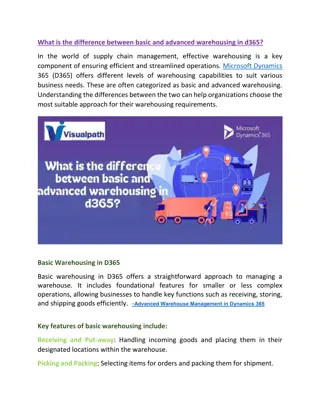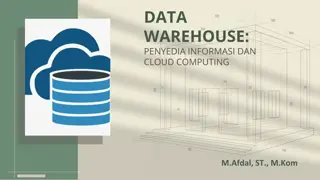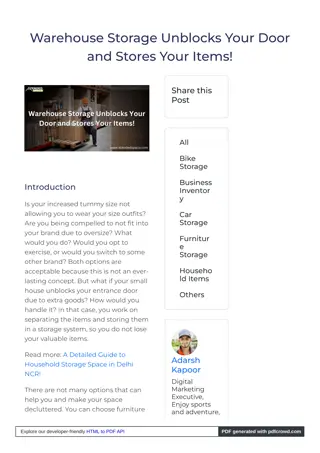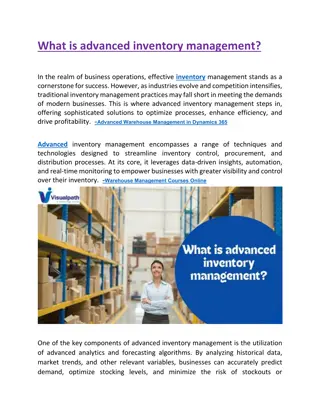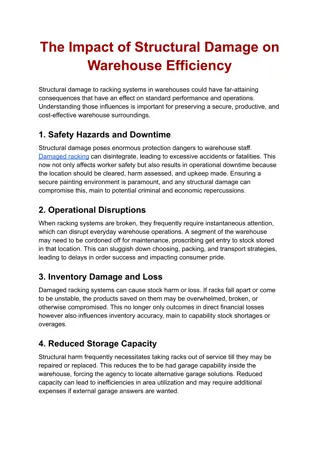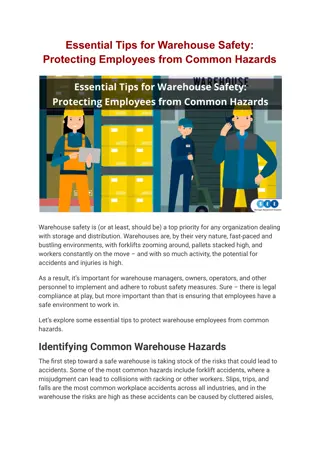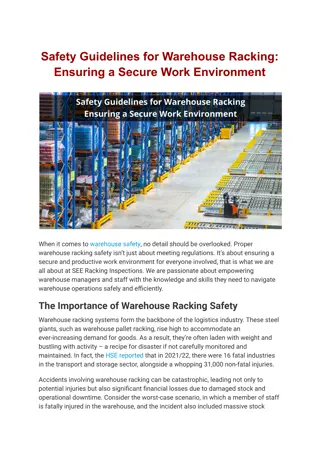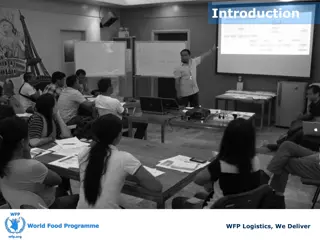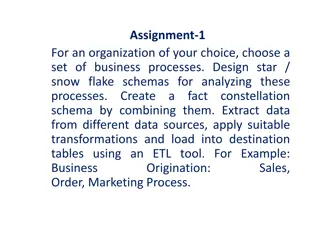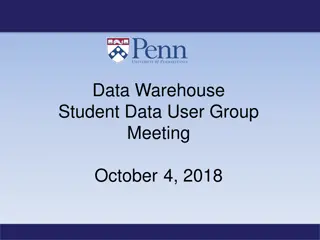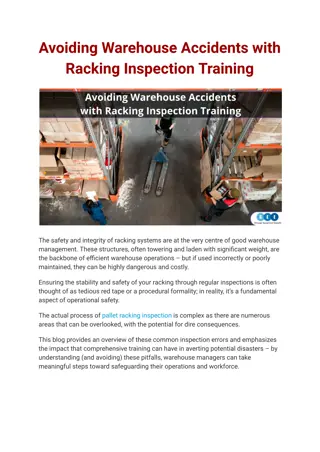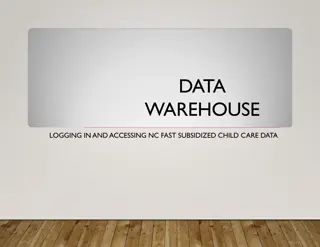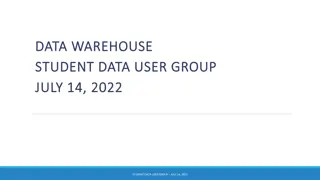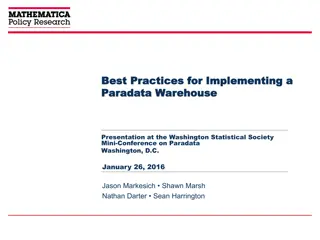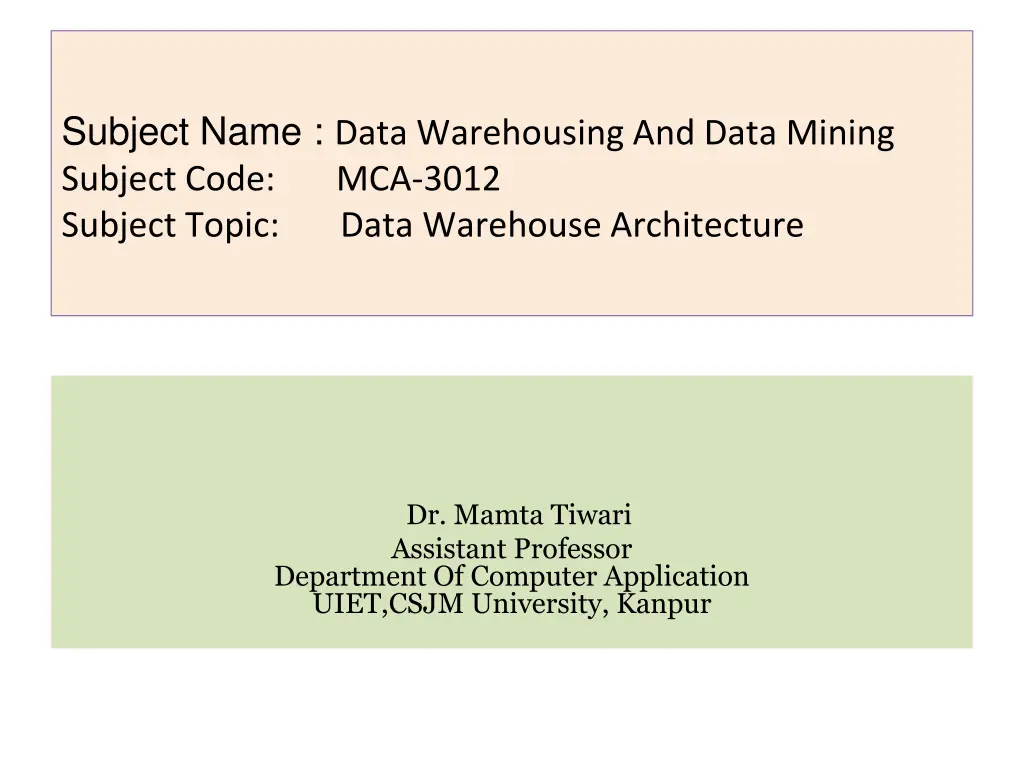
Understanding Data Warehousing Architecture and Functionality
Explore the architecture and functionality of data warehouses, including concepts like roll-up, drill-down, slice and dice, pivot, and cloud-based solutions. Learn how data warehouses gather and utilize data for informed decision-making. Discover the differences between traditional and cloud-based data warehouse architectures. Dive into topics such as enhancing spreadsheet functionality, efficient query processing, ad hoc queries, and data mining in the context of data warehousing and data mining. Dr. Mamta Tiwari, an Assistant Professor at CSJM University, Kanpur, sheds light on the subject.
Uploaded on | 0 Views
Download Presentation

Please find below an Image/Link to download the presentation.
The content on the website is provided AS IS for your information and personal use only. It may not be sold, licensed, or shared on other websites without obtaining consent from the author. If you encounter any issues during the download, it is possible that the publisher has removed the file from their server.
You are allowed to download the files provided on this website for personal or commercial use, subject to the condition that they are used lawfully. All files are the property of their respective owners.
The content on the website is provided AS IS for your information and personal use only. It may not be sold, licensed, or shared on other websites without obtaining consent from the author.
E N D
Presentation Transcript
Subject Name : Data Warehousing And Data Mining Subject Code: MCA-3012 Subject Topic: Data Warehouse Architecture Dr. Mamta Tiwari Assistant Professor Department Of Computer Application UIET,CSJM University, Kanpur
Functionality of Data warehouse The data warehouse access component supports enhanced spreadsheet functionality, efficient query processing, structured queries, ad hoc queries, data mining, and materialized views. In particular, enhanced spreadsheet functionality includes support for state-of-the-art spreadsheet applications (for example, MS Excel) as well as for OLAP applications programs. These offer preprogrammed functionalities
Functionality of Data warehouse Roll-up aggregation on a data cube,eihter by climbing up a concept hierarchy for a dimension. Data is summarized with increasing example,weekely to quartely to annually) The roll-up operation perform eralization(for
Drill-down Drill-down is the reverse of roll-up. It navigates from less detailed data to more detailed data. Drill-down is stepping down a concept hierarchy Increasing levels of detail are revealed for dimension.
Slice and Dice The slice operation perform a selection on one dimension of the given cube, resulting in a sub- cube The performing a selection on two or more dimension dice operation defines a sub-cube by
Pivot(rotate) Pivot is a visualization operation tat rotates the data axes in order to provide an alternative presentation of the data. Cross rotation) is performed tabulation (also referred to as
Data Warehouse Architecture A data warehouse is an electronic system that gathers data from a wide range of sources within a company and uses the data to support management decision- making. Data Warehouse Architecture: Traditional vs. Cloud
Cloud-based data warehouses differ from traditional warehouses in the following ways: There is no need to purchase physical hardware. It s quicker and cheaper to set up and scale cloud data warehouses. Cloud-based data warehouse architectures can typically perform complex analytical queries much faster because they use massively parallel processing (MPP).
Traditional Data Warehouse Architecture Traditional data warehouse architecture employs a three-tier structure composed of the following tiers. Bottom tier: This tier contains the database server used to extract data from many different sources, such as from transactional databases used for front-end application. Middle tier: The middle tier houses an OLAP server, which transforms the data into a structure better suited for analysis and complex querying. The OLAP server can work in two ways: either as an extended relational database management system that maps the operations on multidimensional data to standard relational operations (Relational OLAP), or using a multidimensional OLAP model that directly implements the multidimensional data and operations. Top tier: The top tier is the client layer. This tier holds the tools used for high- level data analysis, querying reporting, and data mining.
Data Warehouse Models In a traditional architecture there are three common data warehouse models: virtual warehouse, data mart, and enterprise data warehouse: Virtual data warehouse is a set of separate databases, which can be queried together, so a user can effectively access all the data as if it was stored in one data warehouse. Data mart model is used for business-line specific reporting and analysis. In this data warehouse model, data is aggregated from a range of source systems relevant to a specific business area, such as sales or finance. Enterprise data warehouse model prescribes that the data warehouse contain aggregated data that spans the entire organization. This model sees the data warehouse as the heart of the enterprise s information system, with integrated data from all business units.
New Data Warehouse Architectures In recent years, data warehouses are moving to the cloud. The new cloud-based data warehouses do not adhere to the traditional architecture; each data warehouse offering has a unique architecture. This section summarizes the architectures used by two of the most popular cloud-based warehouses: Amazon Redshift and Google BigQuery.
Amazon Redshift Amazon Redshift is a cloud-based representation of a traditional data warehouse. Redshift requires computing resources to be provisioned and set up in the form of clusters, which contain a collection of one or more nodes. Each node has its own CPU, storage, and RAM. A leader node compiles queries and transfers them to compute nodes, which execute the queries. On each node, data is stored in chunks, called slices. Redshift uses a columnar storage, meaning each block of data contains values from a single column across a number of rows, instead of a single row with values from multiple columns.
Redshift uses an MPP architecture, breaking up large data sets into chunks which are assigned to slices within each node. Queries perform faster because the compute nodes process queries in each slice simultaneously. The Leader Node aggregates the results and returns them to the client application. Client applications, such as BI and analytics tools, can directly connect to Redshift using open source PostgreSQL JDBC and ODBC drivers. Analysts can thus perform their tasks directly on the Redshift data. Redshift can load only structured data. It is possible to load data to Redshift using pre-integrated systems including Amazon S3 and DynamoDB, by pushing data from any on-premise host with SSH connectivity, or by integrating other data sources using the Redshift API.
Google Big Query BigQuery s architecture is serverless, meaning Google dynamically manages the allocation of machine resources. All resource management decisions are, therefore, hidden from the user. BigQuery lets clients load data from Google Cloud Storage and other readable data sources. The alternative option is to stream data, which allows developers to add data to the data warehouse in real-time, row- by-row, as it becomes available. BigQuery uses a query execution engine named Dremel, which can scan billions of rows of data in just a few seconds. Dremel uses massively parallel querying to scan data in the underlying Colossus file management system. Colossus distributes files into chunks of 64 megabytes among many computing resources named nodes, which are grouped into clusters. Dremel uses a columnar data structure, similar to Redshift. A tree architecture dispatches queries among thousands of machines in seconds
References [1] https://www.tutorialspoint.com/dbms/dbms_overview.htm [2] https://www.studytonight.com/dbms/database-model.php [3] https://www.javatpoint.com/what-is-meta-data [4] https://www.analyticsvidhya.com/blog/2021/05/introduction- to-data-mining-and-its-applications/ [5] https://panoply.io/data-warehouse-guide/ [6] Data warehousing, Data Mining & OLAP by Alex Berson,Stephen J.Smith ,TMH [7] Data Mining Concepts and techniques by Jiawei Han and Micheline Kamber



